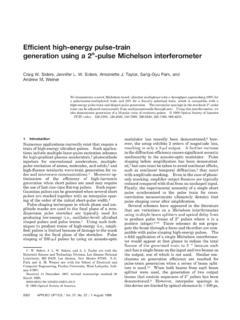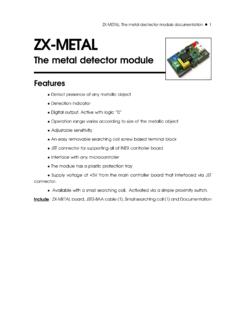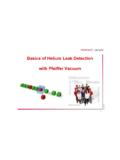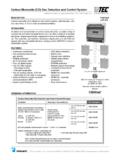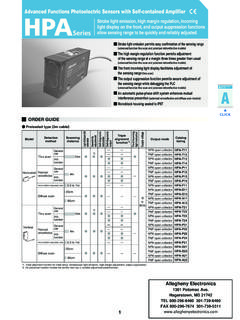Transcription of Hidden object detection: security a pplications of ...
1 Hidden object detection : security applications of terahertz technology William R. Tribe, David A. Newnham, Philip F. Taday, and Michael C. Kemp* TeraView Limited, 302/304 Cambridge Science Park, Milton Road, Cambridge, CB4 0WG, United Kingdom ABSTRACT Recent events have led to dramatic changes to the methods employed in security screening. For example, following the failed shoe bombing, it is now common for shoes to be removed and X-rayed at airport checkpoints. There is therefore an increasing focus on new technologies that can be applied to security screening, either to simplify or speed up the checking process, or to provide additional functionality. Terahertz (THz) technology is a promising, emerging candidate.
2 In previous publications we have shown how our THz pulsed imaging systems can be used to image threat items, and have demonstrated that explosive materials have characteristic THz We have also demonstrated that non-metallic weaponry can be imaged when concealed beneath clothing. In this work we examine more closely the properties of barrier and potential confusion materials. We demonstrate that barrier materials have smooth spectra with relatively low attenuation. We further demonstrate that the terahertz spectra of several common chemicals and medicines are distinct from those of threat materials. Keywords: security screening, terahertz, applications, explosive detection , people screening, imaging, spectroscopy 1.
3 INTRODUCTION Critical issues in security screening Recent events have demonstrated the need for ever more effective security screening, and for systems capable of detecting contraband. A wide variety of techniques are already available, for the detection of a variety of threats, such as weapons or explosives, or illicit items, ranging from drugs to illegal immigrants. Current methods of bag screening in the United States and elsewhere typically use X-ray inspection techniques with some use of further image analysis, manual search and chemical trace detection . Passenger screening relies heavily on archway and handheld metal detectors that are deployed throughout most airports.
4 However, these techniques are not foolproof, and beneficial enhancements could be made in detecting the following : Weapons containing a small amount of metal; Ceramic weapons; Explosive materials; Chemical and biological threats. Emerging technologies, such as X-ray backscatter and millimeter wave imaging might be employed to address some current deficiencies. However, the routine use of ionising X-rays raises health concerns, whilst millimeter wave approaches have a limited spatial resolution. It is also unclear whether either technique can provide spectroscopic substance identification. Thus, X-ray and millimeter wave portals are likely to prompt frequent further searching whenever an image indicates a suspect item or area.
5 False alarms can greatly increase the cost and reduce the throughput of screening systems; throughput is crucial in high-volume situations such as in major airports. A further factor is the high dependence of current techniques on human * phone: 44 1223 435504; fax: 44 1223 435382; Invited PaperTerahertz and Gigahertz Electronics and Photonics III, edited by R. Jennifer Hwu, Proc. of SPIEVol. 5354 (SPIE, Bellingham, WA, 2004) 0277-786X/04/$15 doi: Any new technique that can enhance capability, and aid in the targeting of manual search operations to specific high-risk objects or areas, would be of major benefit. New detection technologies can play an important role in addressing these issues.
6 Whilst there will be stand-alone applications, new approaches will more frequently complement rather than replace established techniques. This will provide richer data that can be fused to provide the basis of highly automated detection systems in multi-threat, multi-modal screening portals. Terahertz radiation and its properties The terahertz gap - where up until recently bright sources of light and sensitive means of detection did not exist - lies between 40 GHz ( cm-1) and 10 THz (300 cm-1). This is between the millimetre/microwave part of the spectrum and the mid-infrared. Conventional microwave sources do not work fast enough to produce radiation efficiently at frequencies above a few hundred gigahertz, whereas diode laser sources have been limited by thermal effects to the infrared and visible.
7 However, in recent years, several approaches have been developed that enable the efficient generation and detection of terahertz radiation, using experimental schemes that are truly commercially viable. The most mature technology uses ultra-fast pulsed laser technology, and produces very short terahertz pulses. As a pulsed technique, with picosecond timescales, the method is intrinsically broadband. Radiation at terahertz frequencies has unique properties that may be advantageous for security applications. It penetrates many non-conducting materials, but unlike X-rays is non-ionising. The short pulses produced by laser techniques also allow radar-like imaging in three dimensions, as well as the simultaneous collection of spectroscopic information as in magnetic resonance imaging (MRI) or optical spectroscopy.
8 This is important because many substances have characteristic intermolecular vibrations at terahertz frequencies that can be used to characterise them as molecules. This contrasts with the detection of bond vibrations of individual molecules, that is the basis of infrared spectroscopy. The four key properties of terahertz imaging which make it a potentially powerful technique in security screening applications are: 2D imaging the terahertz reflection and absorption properties of materials differ from their optical and X-ray behavior: clothing, paper, and card are effectively transparent while plastic and ceramic objects are easily visible in terahertz imaging. Plastics and ceramic materials are hard to pick out using backscatter X-ray techniques as there is little contrast between the human body and these materials.
9 High resolution 3D imaging the extremely short pulses used in pulsed terahertz techniques enable 3D imaging, much like radar. For example, thin layers of powder and individual pages can be resolved inside an envelope. Spectroscopy this enables characteristic signatures of different chemicals to be detected, even when sealed inside a packet or concealed in clothing. Safety terahertz radiation is non-ionizing2 These properties also lead to applications in other areas, for example in medical imaging where it can detect skin cancer,3 in pharmaceutical manufacturing for polymorph detection ,4 and in a variety of industrial inspection applications. The millimeter and microwave region can give spectroscopic rotational information about gaseous molecules while the mid-infrared accesses the molecular finger-print region, where features are due to intra-molecular stretching and bending vibrations between atoms.
10 Assignment of these vibrational modes can lead to an understanding of the conformation of the molecule. In the terahertz region the spectral information comes from the collective modes of lattice structure (or phonon vibrations) in solid materials. This makes the technique very sensitive to both the crystalline conformation and polymorphic form of the material in the solid phase, and to some higher frequency molecular rotations in gas phase materials. The liquid phase spectroscopic information is a complex mixture of rotational and transitional modes. Proc. of SPIE Vol. 5354 Terahertz pulsed spectroscopy Terahertz pulsed spectroscopy (TPS) is a promising new technique which may have much relevance to the security industry.



